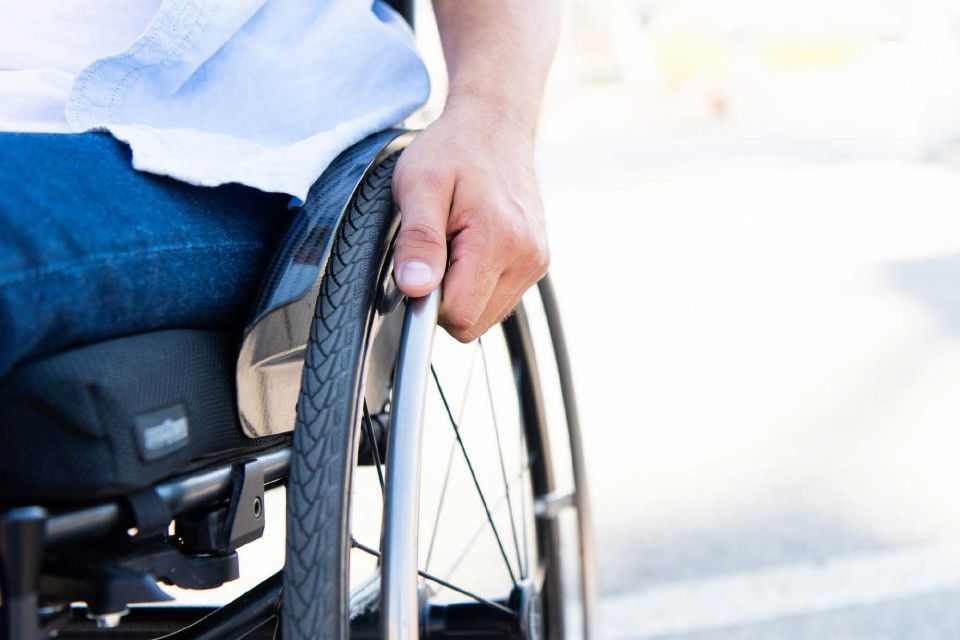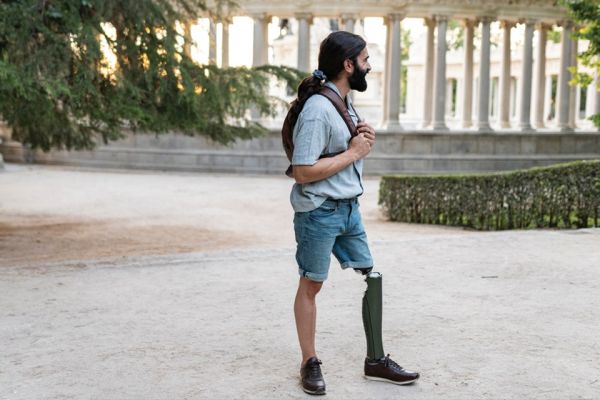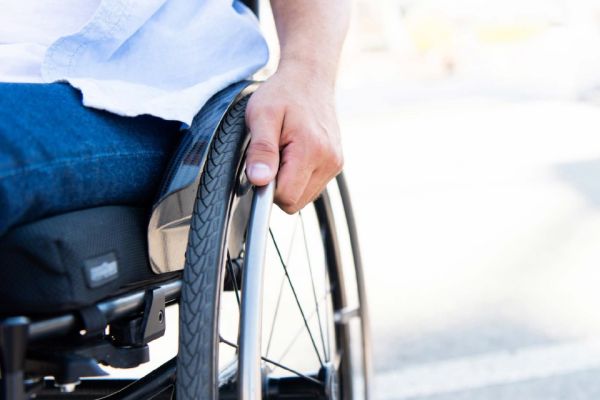Wheelchair Back-Up Plan

Physiotherapist Shirleen Campbell explains the importance of a wheelchair as a mobility option for prosthetic-wearing amputees.
Shirleen Campbell, BSc, PT, is a member of the Canadian Physiotherapist Association and works almost exclusively with amputees, mostly in the area of prosthetic gait training. She’s been doing this work for her entire career. As a physiotherapy student, her course work introduced her to a variety of populations but it was an amputee program that confirmed for her that working with the limb loss population was exactly what she wanted to do.
“I still love what I am doing 30 years later.”
thrive: What exactly do you do?
Shirleen: I am an assessor for the Assistive Devices Program [Ontario] which I do in clinical settings and with home visits. I get referrals from many different sources, prosthetic clinics included.
thrive: With respect to wheelchairs as a mobility option for amputees, do you prescribe them?
Shirleen: I am very familiar with wheelchairs but I don’t prescribe them. That falls to an occupational therapist (OT) who is trained as a mobility assessor. I’ve seen wheelchairs that are very appropriate for an amputee, and I’ve seen those that are not. It is very much based on the individual’s need. The way Ontario’s Assistive Devices Program (ADP) works is that if you require, or will use, a wheelchair for six months or longer it is prescribed. So, for someone who only needs it for three months let’s say, it’s not the best use of ADP money and a rental is more appropriate. ADP will pay for both a prosthesis and a wheelchair if a functional reason for both is shown.
thrive: So, how is “six months or longer” determined?
Shirleen: Those who really benefit from a chair are people who need it as a back-up. Those who shouldn’t be doing any kind of hopping on one leg. Amputees with cardiac conditions, diabetics, people with neuropathy and skin issues, any kind of ulcers, people with COPD… they all need some kind of back-up. And then there are those who use a prosthesis in their home and can walk short distances with it but need something for longer distances.
Some with fatigue issues may need it for rest when they’re in their community, where there may not be anywhere else to sit, or they have pain issues. Trans- femoral amputees get tired faster. A rollator works too. A wheelchair is also beneficial as a transfer aid for trans-femoral amputees too. They can be fully functional with a prosthesis but use a wheelchair to get out of bed, or to the toilet at night.
thrive: On the flip side, are there scenarios where you wouldn’t recommend a wheelchair?
Shirleen: I sometimes question if some with traumatic amputations need one. If they have no problem with their upper body or sound leg, I encourage them to use crutches when needed. Here’s why… a lot of wheelchair sitting leads to tightening of hips which is detrimental to gait pattern. If your hip is tight, what can result is loss of good extension, and back pain, and then the amputee starts compensating for that. Especially, again, for above-knee amputees. Sitting for long periods makes alignment harder to achieve, and the knee doesn’t release the way it is designed to, and it changes gait and the way they move. Full extension at the hip and knee makes a huge difference. You stand up straighter. You have better balance when your hips aren’t tight. You’re up over top of your feet and not leaning over them, or back.
thrive: Staying with traumatic injuries, residual limbs can be quite compromised with complications for weight-bearing.
Shirleen: If the pain is because of ambulating on both limbs, using crutches without the prosthesis would alleviate that. Same for skin breakdown. What’s most important is that when someone can’t wear a prosthetic device for whatever reason, there is a mobility option. For some it may be a wheelchair and for others it may be crutches.
thrive: I’ve heard it said that “crutches are dangerous”?
Shirleen: That’s not a fair global statement. Someone who uses crutches needs good balance, good proprioception, good upper body strength and shoulder stability. Long-term use is not good because elbow, wrist and shoulder injuries can show up down the road.
But they’re good as a back-up option when someone isn’t wearing their prosthesis… and was trained to use crutches correctly so they know how to swing through, how to get up and down stairs safely, how to maintain balance with a rail and without a rail, how to get up and off a curb, and across different types of terrain. Especially with forearm crutches with which you can walk on pretty much anything. They’re good for keeping the leg in a more natural position, and good for cardio too. Axillary crutches versus forearm crutches – it’s a user-specific choice. I have a client who has a prosthesis, a wheelchair, crutches and a rollator. Crutches are for her stairs and letting the dog out when she doesn’t have her prosthesis on. She uses her wheelchair in the morning and when she can’t wear her prosthesis. The rollator gives her a place to sit when she goes out. She’s using all four devices in a functional manner.
thrive: What about a mom who wants to keep up with her kids at the park? Is it reasonable for both a prosthesis and a wheelchair?
Shirleen: Absolutely! Endurance issues because of balance and energy expenditure to walk longer distances with a prosthesis are very real.
thrive: Any other cautionary wheelchair notes?
Shirleen: Moving over uneven ground with a wheelchair is a consideration. If the goal is to get someone back to their pre-accident level of function, relying too much on a chair early on can impact their return to their active life.
As mentioned, prosthesis wearers shouldn’t spend too much time in the chair because it makes using the prosthesis more difficult. My rule of thumb is if you use both, you need to be doing your stretches... standing, laying on your back, whatever it may be. This, actually, goes for anyone who spends a lot of time sitting. We are not designed to sit; we are designed to be up and moving.
thrive: How about wheelchair fit? One size doesn’t fit all, right?
Shirleen: Make sure it is prescribed for you. People come in all different shapes and sizes. There are all kinds of things to consider like width, height and weight, and intended use… for home or for outdoor use. A chair that is too tight can lend to bad posture, hips get rolled in, and skin and pressure issues can follow. Make sure the cushion is right for you. OTs know what is best depending on skin condition, presence of scarring, and how long one will be sitting. A supportive back rest is important. Centre of gravity is important to prevent tipping and balance. Measurements should include chair frame height, back height, and armrest positioning. For example, chairs with the armrests placed further back – for pulling up closer to tables – don’t always work when it comes to transferring out of the chair with their arms behind them.
And maintenance is very important too… pet hair gets caught around the casters. Brakes and bearings need upkeep and tire tread needs to be checked. A once-a-year maintenance check is a good idea. Call a vendor or an OT or a rehab assessor for a referral for service.
Shirleen: I am an assessor for the Assistive Devices Program [Ontario] which I do in clinical settings and with home visits. I get referrals from many different sources, prosthetic clinics included.
thrive: With respect to wheelchairs as a mobility option for amputees, do you prescribe them?
Shirleen: I am very familiar with wheelchairs but I don’t prescribe them. That falls to an occupational therapist (OT) who is trained as a mobility assessor. I’ve seen wheelchairs that are very appropriate for an amputee, and I’ve seen those that are not. It is very much based on the individual’s need. The way Ontario’s Assistive Devices Program (ADP) works is that if you require, or will use, a wheelchair for six months or longer it is prescribed. So, for someone who only needs it for three months let’s say, it’s not the best use of ADP money and a rental is more appropriate. ADP will pay for both a prosthesis and a wheelchair if a functional reason for both is shown.
thrive: So, how is “six months or longer” determined?
Shirleen: Those who really benefit from a chair are people who need it as a back-up. Those who shouldn’t be doing any kind of hopping on one leg. Amputees with cardiac conditions, diabetics, people with neuropathy and skin issues, any kind of ulcers, people with COPD… they all need some kind of back-up. And then there are those who use a prosthesis in their home and can walk short distances with it but need something for longer distances.
Some with fatigue issues may need it for rest when they’re in their community, where there may not be anywhere else to sit, or they have pain issues. Trans- femoral amputees get tired faster. A rollator works too. A wheelchair is also beneficial as a transfer aid for trans-femoral amputees too. They can be fully functional with a prosthesis but use a wheelchair to get out of bed, or to the toilet at night.
thrive: On the flip side, are there scenarios where you wouldn’t recommend a wheelchair?
Shirleen: I sometimes question if some with traumatic amputations need one. If they have no problem with their upper body or sound leg, I encourage them to use crutches when needed. Here’s why… a lot of wheelchair sitting leads to tightening of hips which is detrimental to gait pattern. If your hip is tight, what can result is loss of good extension, and back pain, and then the amputee starts compensating for that. Especially, again, for above-knee amputees. Sitting for long periods makes alignment harder to achieve, and the knee doesn’t release the way it is designed to, and it changes gait and the way they move. Full extension at the hip and knee makes a huge difference. You stand up straighter. You have better balance when your hips aren’t tight. You’re up over top of your feet and not leaning over them, or back.
thrive: Staying with traumatic injuries, residual limbs can be quite compromised with complications for weight-bearing.
Shirleen: If the pain is because of ambulating on both limbs, using crutches without the prosthesis would alleviate that. Same for skin breakdown. What’s most important is that when someone can’t wear a prosthetic device for whatever reason, there is a mobility option. For some it may be a wheelchair and for others it may be crutches.
thrive: I’ve heard it said that “crutches are dangerous”?
Shirleen: That’s not a fair global statement. Someone who uses crutches needs good balance, good proprioception, good upper body strength and shoulder stability. Long-term use is not good because elbow, wrist and shoulder injuries can show up down the road.
But they’re good as a back-up option when someone isn’t wearing their prosthesis… and was trained to use crutches correctly so they know how to swing through, how to get up and down stairs safely, how to maintain balance with a rail and without a rail, how to get up and off a curb, and across different types of terrain. Especially with forearm crutches with which you can walk on pretty much anything. They’re good for keeping the leg in a more natural position, and good for cardio too. Axillary crutches versus forearm crutches – it’s a user-specific choice. I have a client who has a prosthesis, a wheelchair, crutches and a rollator. Crutches are for her stairs and letting the dog out when she doesn’t have her prosthesis on. She uses her wheelchair in the morning and when she can’t wear her prosthesis. The rollator gives her a place to sit when she goes out. She’s using all four devices in a functional manner.
thrive: What about a mom who wants to keep up with her kids at the park? Is it reasonable for both a prosthesis and a wheelchair?
Shirleen: Absolutely! Endurance issues because of balance and energy expenditure to walk longer distances with a prosthesis are very real.
thrive: Any other cautionary wheelchair notes?
Shirleen: Moving over uneven ground with a wheelchair is a consideration. If the goal is to get someone back to their pre-accident level of function, relying too much on a chair early on can impact their return to their active life.
As mentioned, prosthesis wearers shouldn’t spend too much time in the chair because it makes using the prosthesis more difficult. My rule of thumb is if you use both, you need to be doing your stretches... standing, laying on your back, whatever it may be. This, actually, goes for anyone who spends a lot of time sitting. We are not designed to sit; we are designed to be up and moving.
thrive: How about wheelchair fit? One size doesn’t fit all, right?
Shirleen: Make sure it is prescribed for you. People come in all different shapes and sizes. There are all kinds of things to consider like width, height and weight, and intended use… for home or for outdoor use. A chair that is too tight can lend to bad posture, hips get rolled in, and skin and pressure issues can follow. Make sure the cushion is right for you. OTs know what is best depending on skin condition, presence of scarring, and how long one will be sitting. A supportive back rest is important. Centre of gravity is important to prevent tipping and balance. Measurements should include chair frame height, back height, and armrest positioning. For example, chairs with the armrests placed further back – for pulling up closer to tables – don’t always work when it comes to transferring out of the chair with their arms behind them.
And maintenance is very important too… pet hair gets caught around the casters. Brakes and bearings need upkeep and tire tread needs to be checked. A once-a-year maintenance check is a good idea. Call a vendor or an OT or a rehab assessor for a referral for service.











 How to resolve AdBlock issue?
How to resolve AdBlock issue?